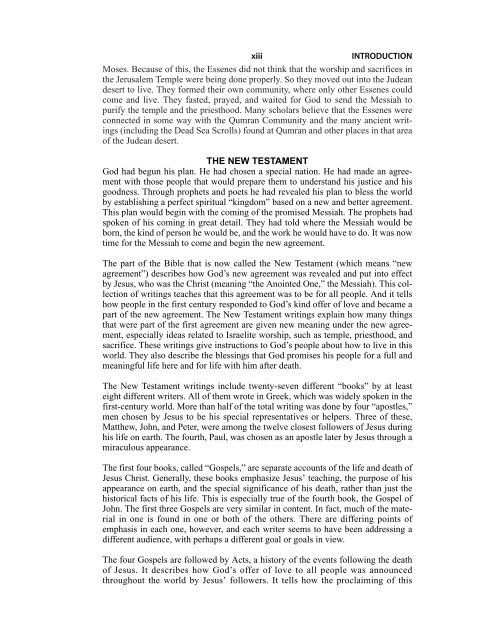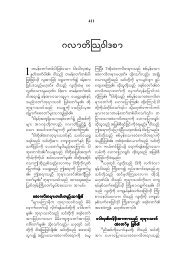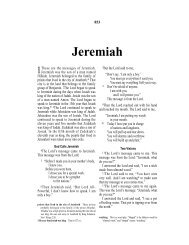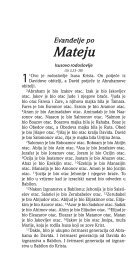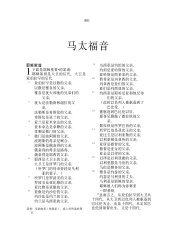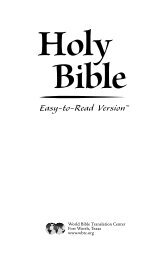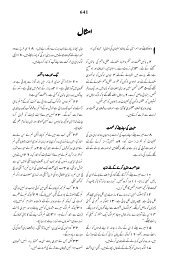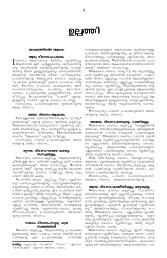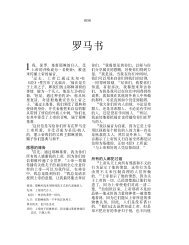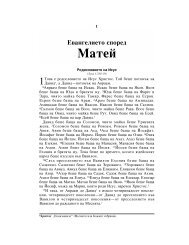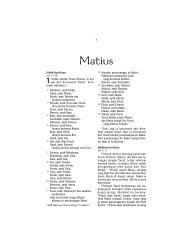English Version for the Deaf
English Version for the Deaf
English Version for the Deaf
Create successful ePaper yourself
Turn your PDF publications into a flip-book with our unique Google optimized e-Paper software.
xiii INTRODUCTION<br />
Moses. Because of this, <strong>the</strong> Essenes did not think that <strong>the</strong> worship and sacrifices in<br />
<strong>the</strong> Jerusalem Temple were being done properly. So <strong>the</strong>y moved out into <strong>the</strong> Judean<br />
desert to live. They <strong>for</strong>med <strong>the</strong>ir own community, where only o<strong>the</strong>r Essenes could<br />
come and live. They fasted, prayed, and waited <strong>for</strong> God to send <strong>the</strong> Messiah to<br />
purify <strong>the</strong> temple and <strong>the</strong> priesthood. Many scholars believe that <strong>the</strong> Essenes were<br />
connected in some way with <strong>the</strong> Qumran Community and <strong>the</strong> many ancient writings<br />
(including <strong>the</strong> Dead Sea Scrolls) found at Qumran and o<strong>the</strong>r places in that area<br />
of <strong>the</strong> Judean desert.<br />
THE NEW TESTAMENT<br />
God had begun his plan. He had chosen a special nation. He had made an agreement<br />
with those people that would prepare <strong>the</strong>m to understand his justice and his<br />
goodness. Through prophets and poets he had revealed his plan to bless <strong>the</strong> world<br />
by establishing a perfect spiritual “kingdom” based on a new and better agreement.<br />
This plan would begin with <strong>the</strong> coming of <strong>the</strong> promised Messiah. The prophets had<br />
spoken of his coming in great detail. They had told where <strong>the</strong> Messiah would be<br />
born, <strong>the</strong> kind of person he would be, and <strong>the</strong> work he would have to do. It was now<br />
time <strong>for</strong> <strong>the</strong> Messiah to come and begin <strong>the</strong> new agreement.<br />
The part of <strong>the</strong> Bible that is now called <strong>the</strong> New Testament (which means “new<br />
agreement”) describes how God’s new agreement was revealed and put into effect<br />
by Jesus, who was <strong>the</strong> Christ (meaning “<strong>the</strong> Anointed One,” <strong>the</strong> Messiah). This collection<br />
of writings teaches that this agreement was to be <strong>for</strong> all people. And it tells<br />
how people in <strong>the</strong> first century responded to God’s kind offer of love and became a<br />
part of <strong>the</strong> new agreement. The New Testament writings explain how many things<br />
that were part of <strong>the</strong> first agreement are given new meaning under <strong>the</strong> new agreement,<br />
especially ideas related to Israelite worship, such as temple, priesthood, and<br />
sacrifice. These writings give instructions to God’s people about how to live in this<br />
world. They also describe <strong>the</strong> blessings that God promises his people <strong>for</strong> a full and<br />
meaningful life here and <strong>for</strong> life with him after death.<br />
The New Testament writings include twenty-seven different “books” by at least<br />
eight different writers. All of <strong>the</strong>m wrote in Greek, which was widely spoken in <strong>the</strong><br />
first-century world. More than half of <strong>the</strong> total writing was done by four “apostles,”<br />
men chosen by Jesus to be his special representatives or helpers. Three of <strong>the</strong>se,<br />
Mat<strong>the</strong>w, John, and Peter, were among <strong>the</strong> twelve closest followers of Jesus during<br />
his life on earth. The fourth, Paul, was chosen as an apostle later by Jesus through a<br />
miraculous appearance.<br />
The first four books, called “Gospels,” are separate accounts of <strong>the</strong> life and death of<br />
Jesus Christ. Generally, <strong>the</strong>se books emphasize Jesus’ teaching, <strong>the</strong> purpose of his<br />
appearance on earth, and <strong>the</strong> special significance of his death, ra<strong>the</strong>r than just <strong>the</strong><br />
historical facts of his life. This is especially true of <strong>the</strong> fourth book, <strong>the</strong> Gospel of<br />
John. The first three Gospels are very similar in content. In fact, much of <strong>the</strong> material<br />
in one is found in one or both of <strong>the</strong> o<strong>the</strong>rs. There are differing points of<br />
emphasis in each one, however, and each writer seems to have been addressing a<br />
different audience, with perhaps a different goal or goals in view.<br />
The four Gospels are followed by Acts, a history of <strong>the</strong> events following <strong>the</strong> death<br />
of Jesus. It describes how God’s offer of love to all people was announced<br />
throughout <strong>the</strong> world by Jesus’ followers. It tells how <strong>the</strong> proclaiming of this


